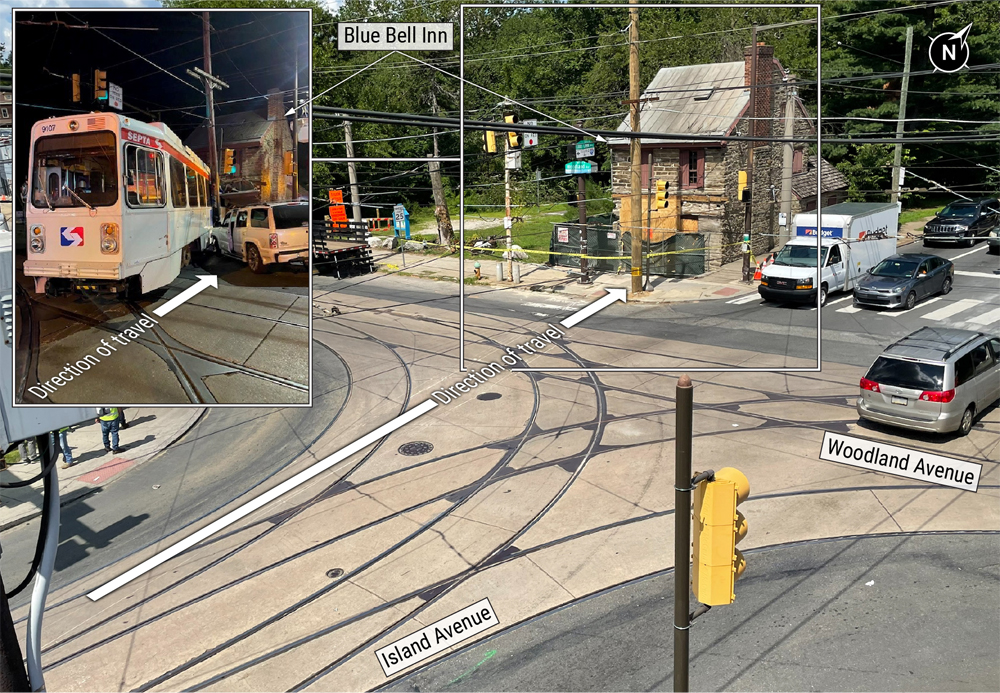
WASHINGTON — A technician who was repositioning a Southeastern Pennsylvania Transportation Authority trolley at a maintenance facility was unaware its brakes had been disabled to allow for repairs when the vehicle ran away, derailed, and struck an SUV and a historic building in Philadelphia on July 27, according to the preliminary National Transportation Safety Board report.
Three people suffered minor injuries: the technician, who jumped from the trolley prior to the derailment, and two people in the SUV. Damage to the light rail vehicle was estimated at $500,000, while the Blue Bell Inn — a structure dating to 1766 — sustained an estimated $300,000 damage [see “Three injured as SEPTA trolley derails …,” Trains News Wire, July 28, 2023]. A resident of the inn was not injured.
The report indicates trolley 9107 (a Kawasaki car built in 1981) was undergoing an air compressor replacement at SEPTA’s Elmwood maintenance facility; this work rendered the air brakes inoperable. Shortly before the incident, a technician was told by a supervisor to move the car for storage; that technician told NTSB investigators he had no indication, such as a tag or note, that the brakes did not work. He moved the car under its own power, but was unable to stop, and it continued on a downgrade along Island Avenue until it derailed at the intersection of Island and Woodland avenues at about 20 mph. There, it struck the SUV and continued into the building.
The ongoing NTSB investigation will focus on SEPTA repair and maintenance practices, including pre-movement procedures and maintenance personnel training and supervision, as well as railroad oversight.
The derailment was one of five incidents involving SEPTA trolleys and buses in a single week in July, leading the Federal Transit Administration to look into the agency’s safety practices [see “FTA involved in investigation …,” News Wire, Aug. 3, 2023]. SEPTA has responded to the rash of problems by ordering mandatory safety retraining for all employees, a process that began Aug. 14 and will continue over an eight-week period. The agency cautions riders to expect delays across its system as 10% of employees are pulled from their regular duties.













While undergoing an “air compressor replacement” with the “air brakes inoperable” wouldn’t the air pressure gauge at the control console read “0”? Isn’t that gauge always checked before any movements?
Air gauge should read zero. With all the other things that didn’t happen why would anybody look at the air gauge?
The article focuses entirely on the air brakes. A Kawasaki car has much more braking ability including magnetic track brakes (like a PCC car)
When I qualified to operate the trolley at the Shelburne Falls Trolley Museum I learned to stop the trolley in an emergency by throwing the reverser into reverse. Was that option unavailable on the SEPTA trolley? I suppose it would only work if the car was still on the track and the pole still connected to the wire. But it should have been done at the first sign that the brakes weren’t working, before the car was out of control.
You put the K-controller in reverse and pull one point of power, It’s not good for the motors but it will stop the car. Then you wind the handbrake to keep it put. If one is availabe you chock the wheels. (belt and baces)
The SEPTA trolley is a “K-car” but a K-controller represemts 1900 technology. It should have all sorts of electric and magnetic brakes. I’d be curious why they didn’t work.
On a curious note, the NTSB says SEPTA “rendered the trolley’s air brakes inoperable to allow for the manual repositioning of the trolley.” 9107 weighs some 29 tons. Can you picture all the shop personnel pushing the car to “allow for the manual repositioning of the trolley.”
Air compressor out and no tag at the operator’s seat? Should still have regenerative/dynamic, unless they cut out ALL the brakes, not just the air.
In any case, it is imperative that SEPTA overhaul itself in terms of safety practices!
Dr. Güntürk Üstün